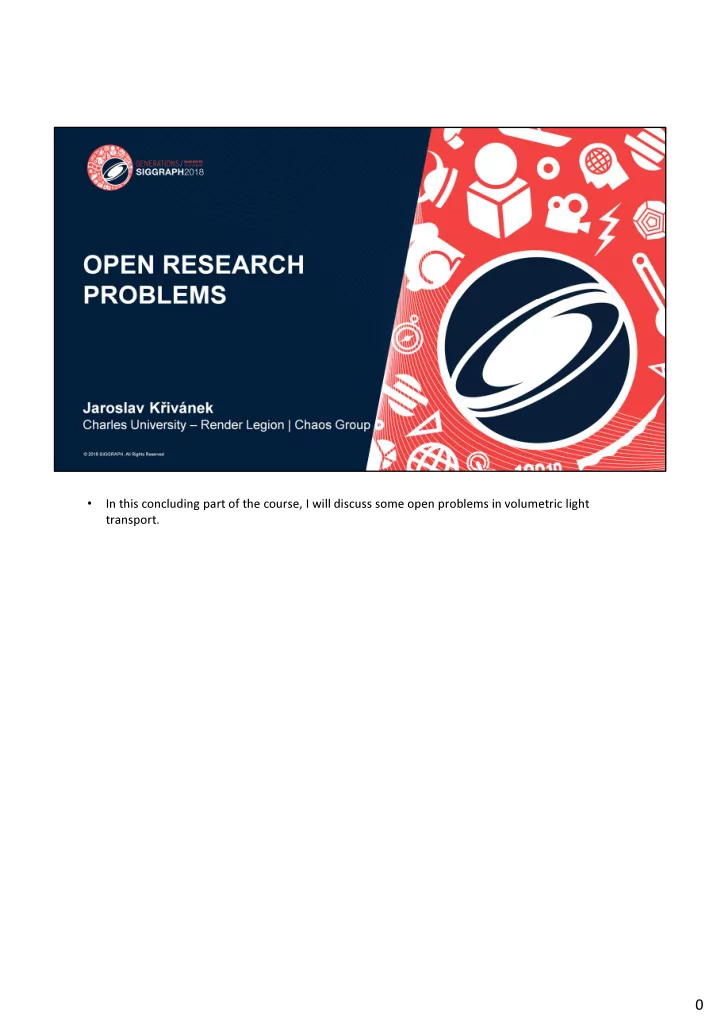

In this concluding part of the course, I will discuss some open problems in volumetric light • transport. 0
The first problem is of course speed: light transport is generally slow, transport in volumes even • slower. Especially in large heterogeneous volumes, just looking up the volume data can easily overwhelm the entire computation budget. Furthermore, the unidirectional estimators commonly used in practice, such as path tracing, are • generally rather fragile: they do not handle well complex lighting such as caustics or strong indirect illumination. They also have trouble with light sources embedded directly into the volumes. Bidirectional methods, such as bidirectional path tracing or UPBP [Křivánek et al. 2014], are more • robust thanks to the use of combined estimators, however they tend to be generally slow, even in the simple cases that the path tracer already handles fairly well. 1
Some more specific problems include calculation of sampling pdfs for the null-collision tracking • algorithms, such as Woodcock tracking. Woodcock tracking is a rejection method of sorts, we know it generates samples from the • appropriate distribution, but we have no way of evaluating the pdf value for a given distance. This prevents the use of Woodcock tracking in bidirectional estimators, where the pdf value is • essential for the calculation of MIS weights (e.g. the balance heuristic) [Veach and Guibas 1995]. 2
One interesting direction for improving the performance of volumetric light transport is the use • of Machine learning. One option, already exploited in surface rendering, is the so called path guiding . Path guiding • refers to adaptive sampling in the path space, with the purpose of preferably sampling paths to scene locations where light sources can be easily reached. Machine learning can be used to learn the guiding distributions (unknown upfront) from the samples used in rendering. The upcoming work of Herholz et al. [2019] goes in this direction, but more work will be needed. Another challenge is denoising of volumetric media, which currently does not work very well. The • main reason is the lack of any reliable features (such as surface normals, depth, texture/albedo) that are readily available for surfaces. For this reason the denoiser has no way of telling noise from actual features. A ML methods trained on a sufficiently large pool of examples could help to improve this. Another interesting direction follows from the realization that – especially in dense media – the • transport has diffusive character, so the solutions are generally rather smooth and stable (in the sense that small perturbations of the volume data will not yield large perturbations of the light transport solution). These facts give some hope that it might be possible to learn – through regression – the light transport solution for canonical configurations. 3
Another interesting direction of future research is the co-called non-classical transport, that is, • transport in media for which the Beer-Lambert law does not hold. Such cases include all media with correlated internal structure (the exponential Beer-Lambert • light falloff assumes uncorrelated particles in the volume). Some recent work in this direction already exists, but efficient rendering methods for such media • are yet to be devised. 4
The volumetric representation can also be though of as a natural unified representation of • scenes. Indeed, for some materials, such as fabrics, surface representation with a texture might be too • limiting, while a volumetric representation easily captures all the intricacies of such materials. A unified volumetric scene representation has the significant advantage of enabling effective • level-of-detail in large scenes. 5
6
Recommend
More recommend